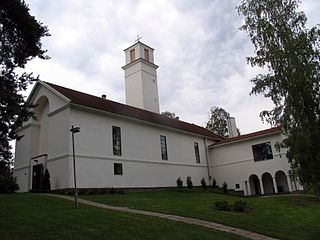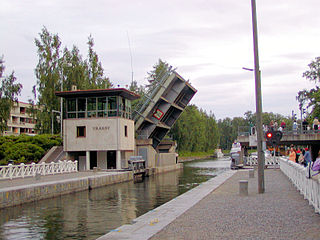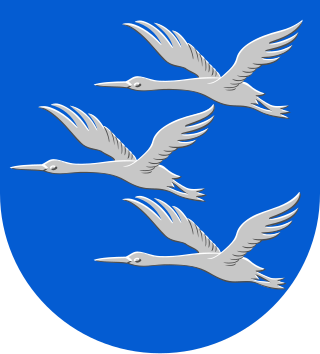
Jyväskylä is a city in Finland and the regional capital of Central Finland. It is located in the Finnish Lakeland. The population of Jyväskylä is approximately 148,000, while the sub-region has a population of approximately 191,000. It is Finland's 7th most populous municipality, and fifth most populous urban area.

Muurame is a municipality of Finland, located 16 kilometres (10 mi) south-west of Jyväskylä. Muurame itself is located between two lakes, Lake Päijänne and Lake Muuratjärvi. These two lakes are connected to each other via River Muurame. All together there are 37 lakes in Muurame. Biggest lakes beside Päijänne are Muuratjärvi and Lake Kuusjärvi. River Muurame streams through the population center of Muurame. Muurame was founded in 1921.

Asikkala is a municipality of Finland. Its seat is in Vääksy, at the shores of the Lake Päijänne. It is located in the province of Southern Finland and is part of the Päijänne Tavastia region. Asikkala's neighboring municipalities are Hämeenlinna, Heinola, Hollola, Lahti, Padasjoki and Sysmä.

Äänekoski is a town in Finland. It is located in the Central Finland region, about 45 kilometres (28 mi) north of Jyväskylä, the region's capital city. Äänekoski has a population of 17,971, as of 31 December 2023, and covers an area of 1,138.39 square kilometres (439.53 sq mi) of which 253.84 km2 (98.01 sq mi), or 22%, is water. The population density is 20.32 inhabitants per square kilometre (52.6/sq mi).

Jyväskylän maalaiskunta, 'The Rural Municipality of Jyväskylä' is a former municipality of Finland. Together with Korpilahti, Jyväskylän maalaiskunta was consolidated with Jyväskylä on 1 January 2009. It was the last municipality to carry the name maalaiskunta.

Hankasalmi is a municipality of Finland.

Laukaa is a municipality of Finland. It is located next to Jyväskylä and is part of the Central Finland region. The municipality has a population of 18,762 and covers an area of 825.59 square kilometres (318.76 sq mi) of which 177.09 km2 (68.37 sq mi) is water. The population density is 28.93 inhabitants per square kilometre (74.9/sq mi).

Luhanka is a municipality of Finland. It is located in the Central Finland region. The municipality has a population of 702 and covers an area of 313.25 square kilometres (120.95 sq mi) of which 98.73 km2 (38.12 sq mi) is water.

Myrskylä is a municipality in Finland, located in the southern interior of the country. Myrskylä is situated in the eastern part of the Uusimaa region, and it is the smallest municipality in the region in relation to its population. The population of Myrskylä is approximately 2,000, while the sub-region has a population of approximately 59,000. It is the 271st most populous municipality in Finland.

Petäjävesi is a municipality of Finland. It is located in the province of Western Finland, next to the city of Jyväskylä, and is part of the Central Finland region. The municipality has a population of 3,596 and covers an area of 495.41 square kilometres (191.28 sq mi) of which 39.01 km2 (15.06 sq mi), or almost 8%, is water. The population density is 7.88 inhabitants per square kilometre (20.4/sq mi).

Saarijärvi is a town and municipality of Finland located in the Central Finland region. The municipality has a population of 8,847, as of 31 December 2023, and covers an area of 1,422.72 square kilometres (549.32 sq mi) of which 170.8 km2 (65.9 sq mi), or 12%, is water. The population density is 7.07 inhabitants per square kilometre (18.3/sq mi).

Soini is a municipality of Finland. It is located in the Southern Ostrobothnia region. The municipality has a population of 1,873 and covers an area of 574.22 square kilometres (221.71 sq mi) of which 22.17 km2 (8.56 sq mi) is water. The population density is 3.39 inhabitants per square kilometre (8.8/sq mi).

Sysmä is a municipality of Finland. It is situated in the Päijät-Häme region. The municipality has a population of 3,496 (31 December 2023) and covers an area of 936.18 square kilometres (361.46 sq mi) of which 269.14 km2 (103.92 sq mi) is water. The population density is 5.24 inhabitants per square kilometre (13.6/sq mi). Neighbouring municipalities are Asikkala, Hartola, Heinola, Kuhmoinen, Luhanka, and Padasjoki. The municipality is unilingually Finnish.

Toivakka is a municipality of Finland. It is located in the Central Finland region, near Jyväskylä. The municipality has a population of 2,368 (31 December 2023) and covers an area of 413.94 square kilometres (159.82 sq mi) of which 52.44 km2 (20.25 sq mi) is water. The population density is 6.55 inhabitants per square kilometre (17.0/sq mi). The municipality is unilingually Finnish.

Nyrölä is a district and village of Jyväskylä, Finland located 30 kilometres (19 mi) from the city centre. Prior to 2009, it was one of the villages of Jyväskylän maalaiskunta.
Keljo is a district of Jyväskylä, in Central Finland, and a former village of Jyväskylän maalaiskunta. The distance to central Jyväskylä is about 4 kilometres (2.5 mi).

Vesanka is a village and a district of the city of Jyväskylä, in Central Finland. Before 2009, it was one of the villages of Jyväskylän maalaiskunta. It is located in the far western part of Jyväskylä near its borders with Petäjävesi, Muurame and, until 2009, Korpilahti.

Tikka-Mannila or Tikkamannila is a village and a district of Jyväskylä in Finland. It was a part of Jyväskylän maalaiskunta until its disestablishment in 2009. It is located to the southeast of Tikkakoski. The national road 4 passes through Tikka-Mannila.

Puuppola is a district of Jyväskylä and a village in Central Finland. Before 2009, it was a part of Jyväskylän maalaiskunta. The national road 4 passes by Puuppola. The distance to central Jyväskylä is roughly 11 km.

Haapaniemi is a district of Jyväskylä in Central Finland, located to the south of Vaajakoski. Before 2009, it was a part of Jyväskylän maalaiskunta and was one of its register villages. The distance to central Jyväskylä is roughly 6 km.























